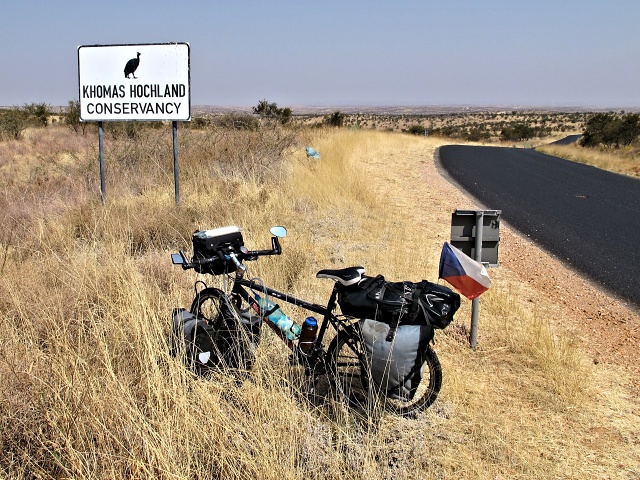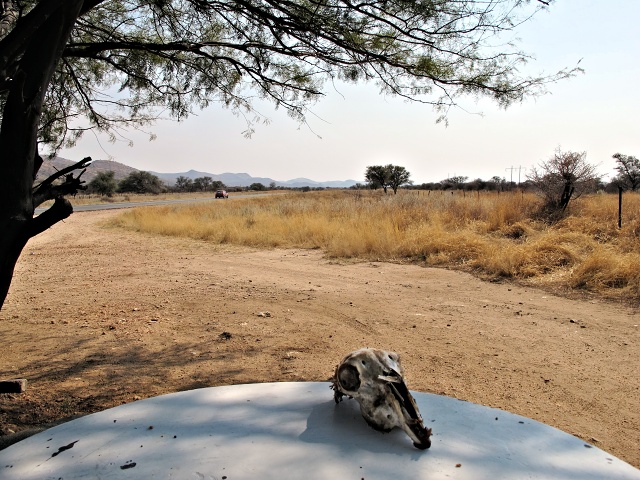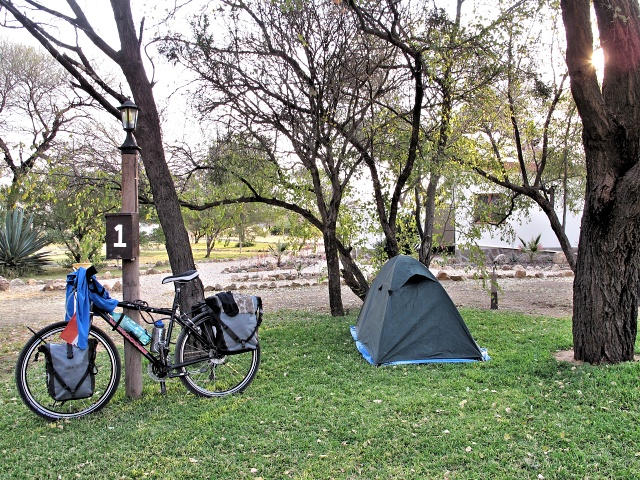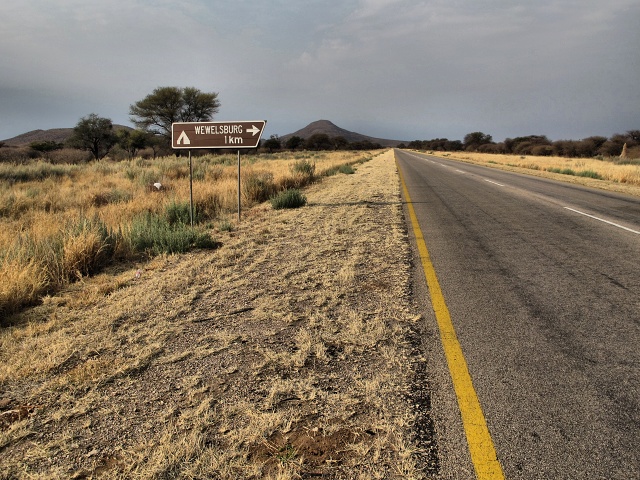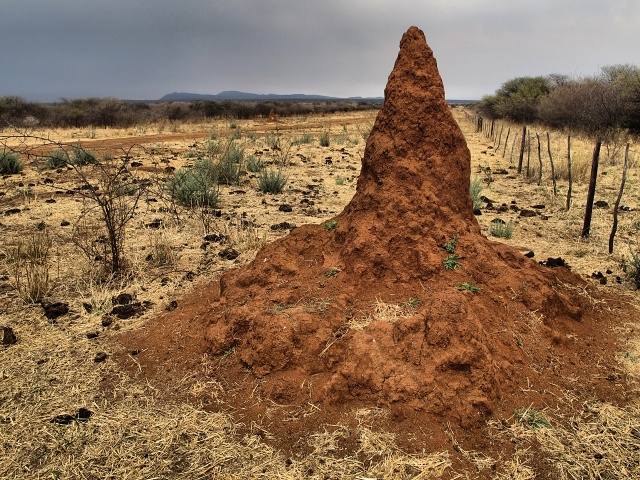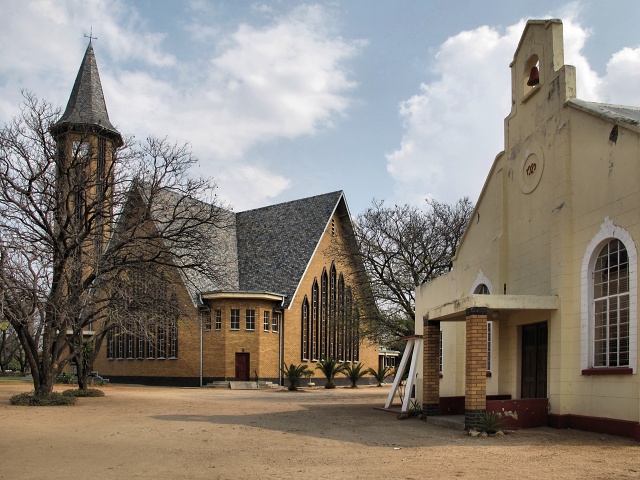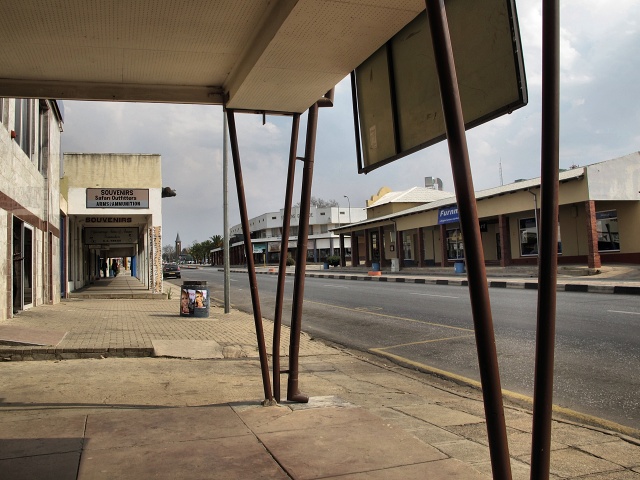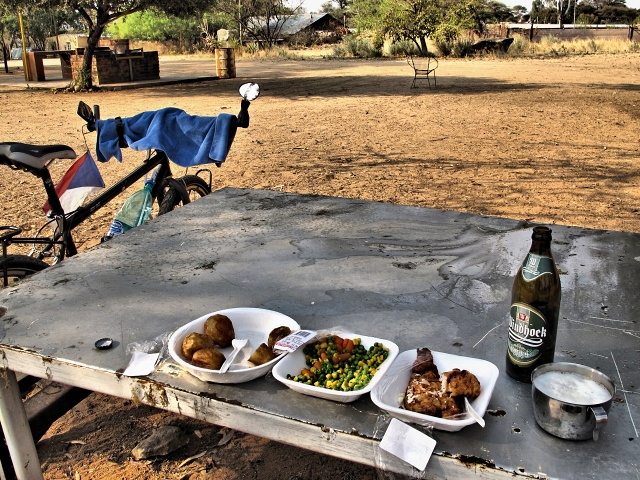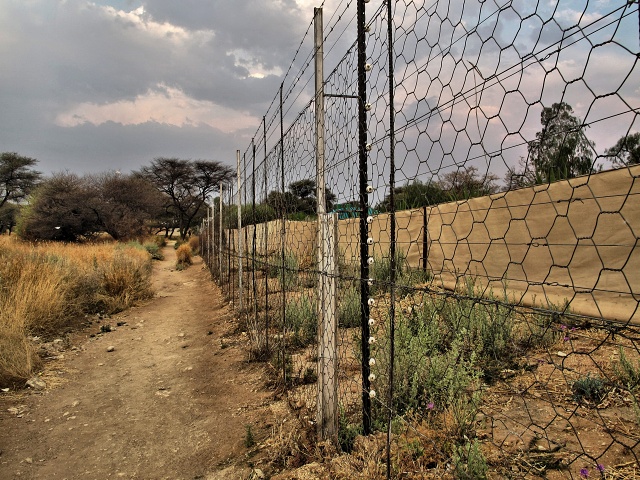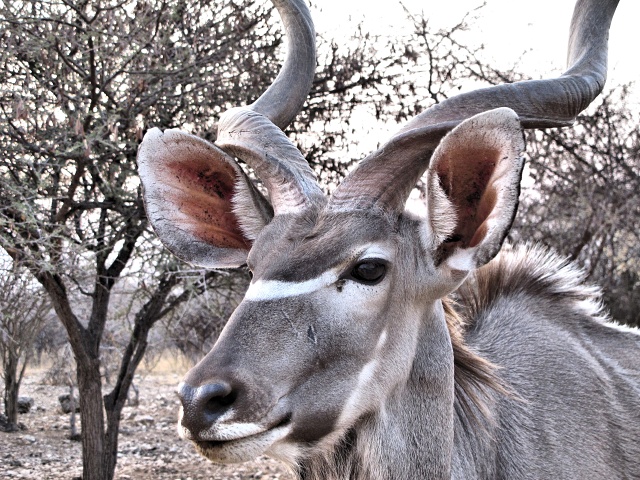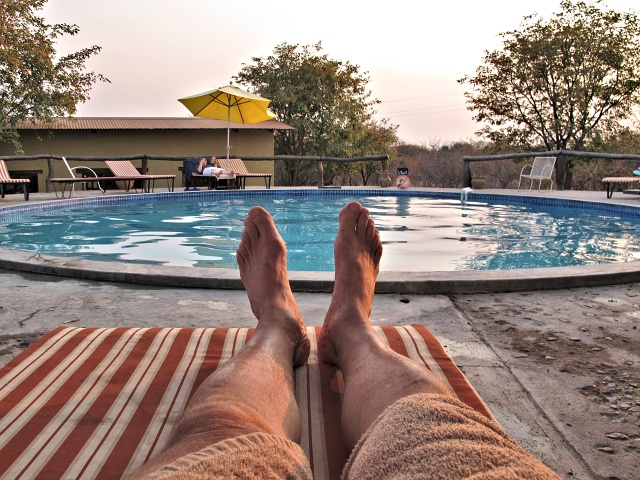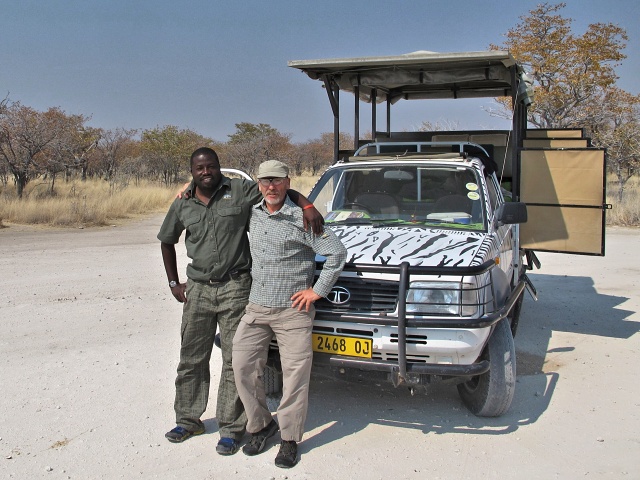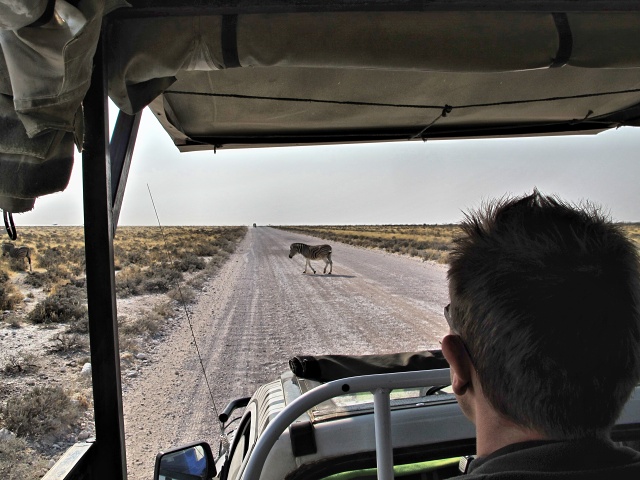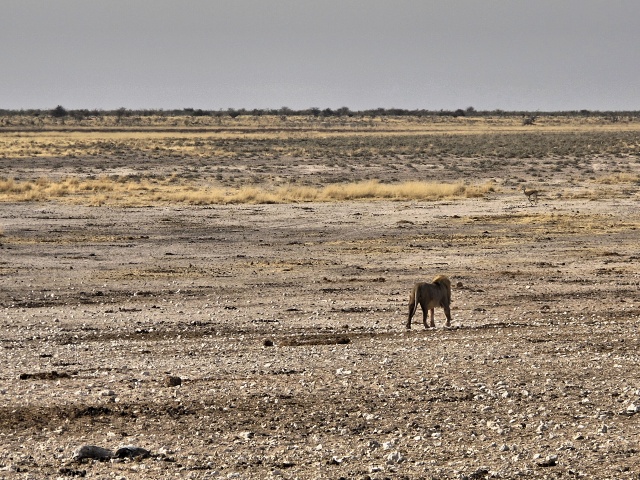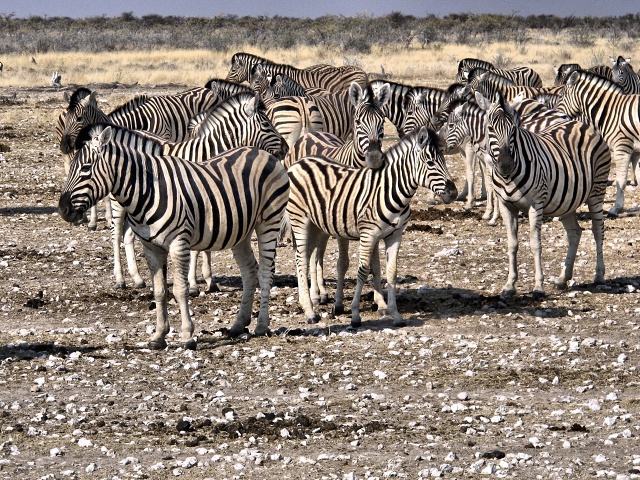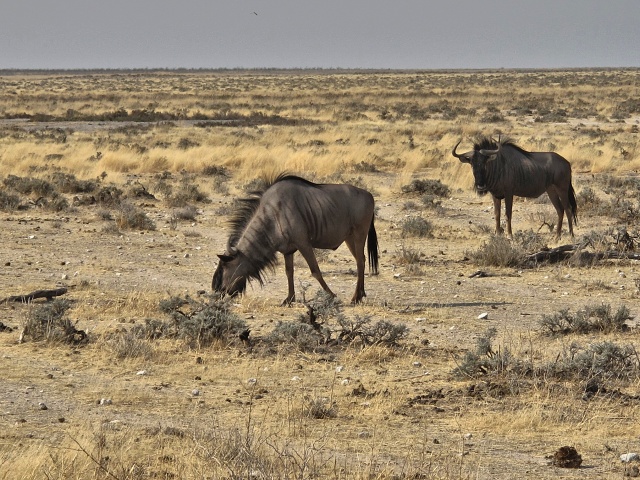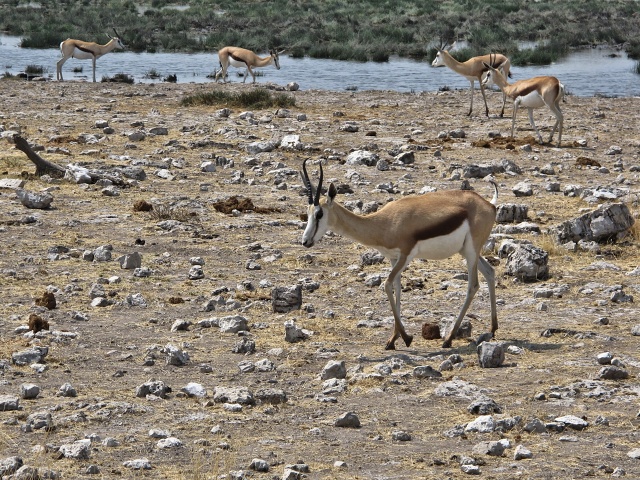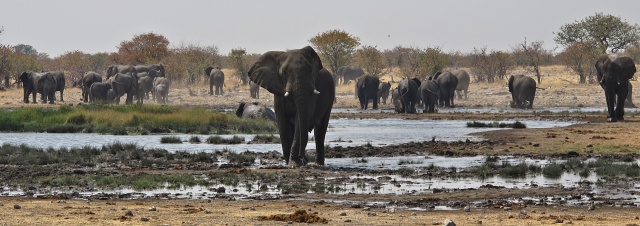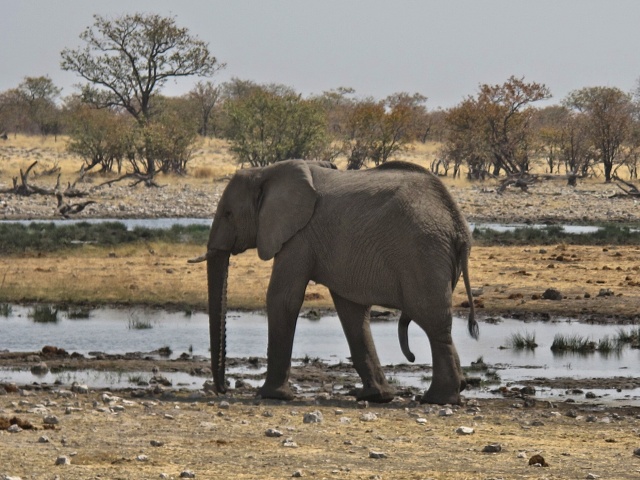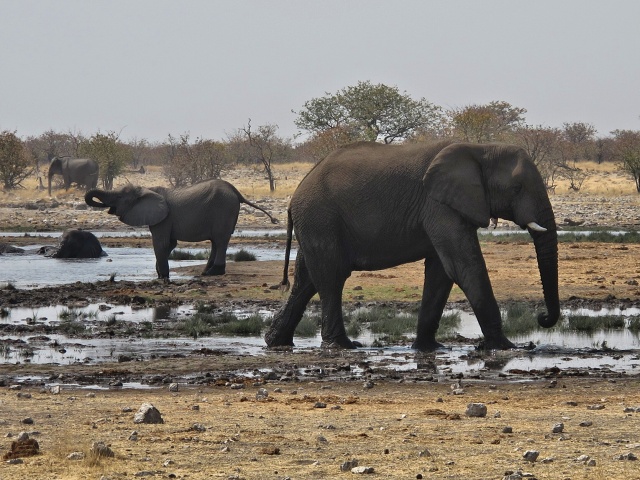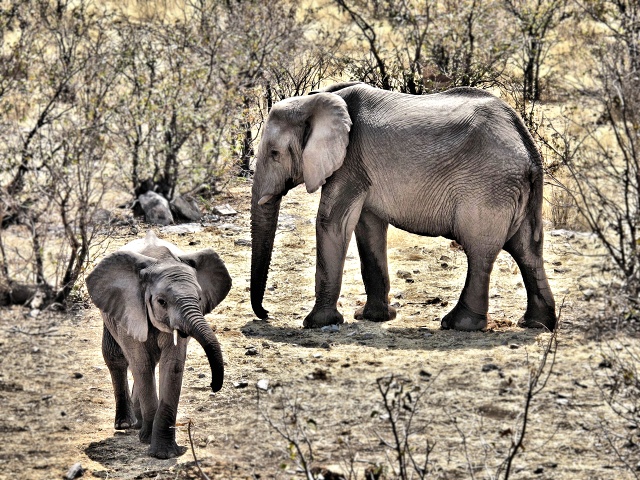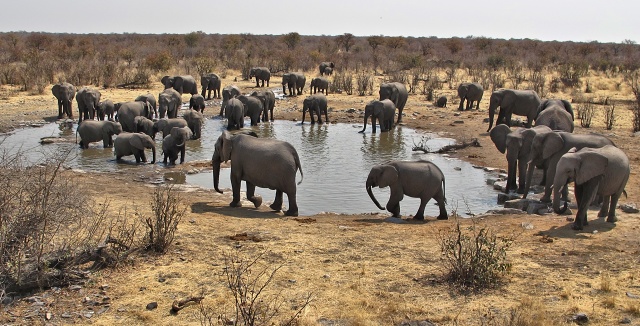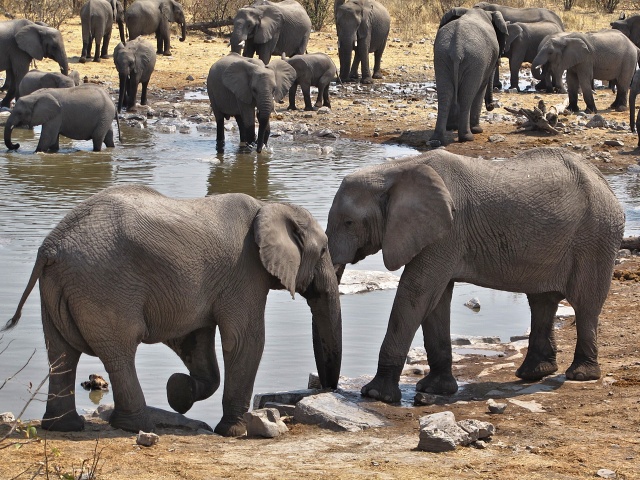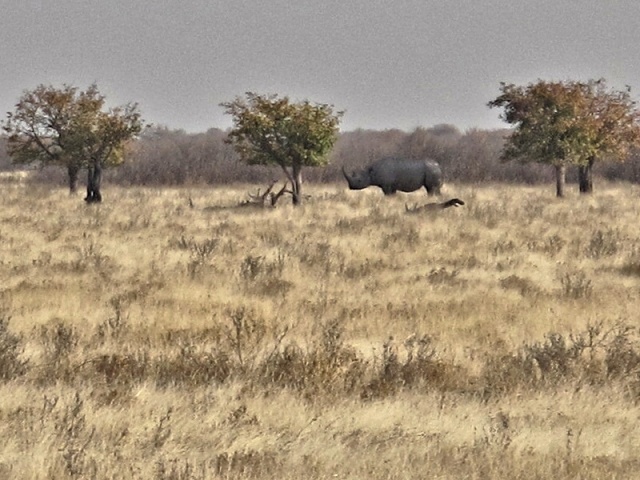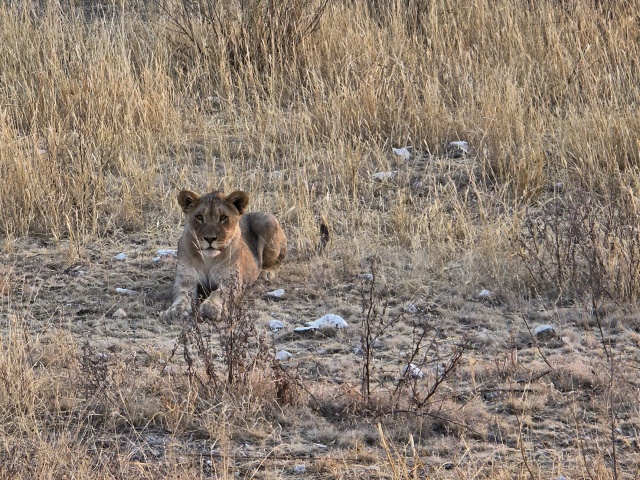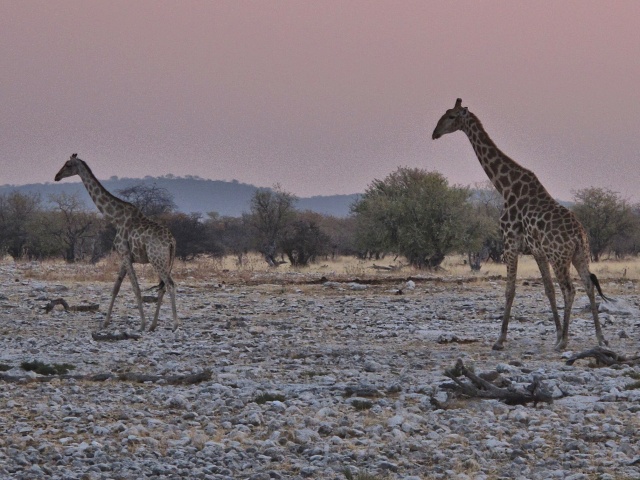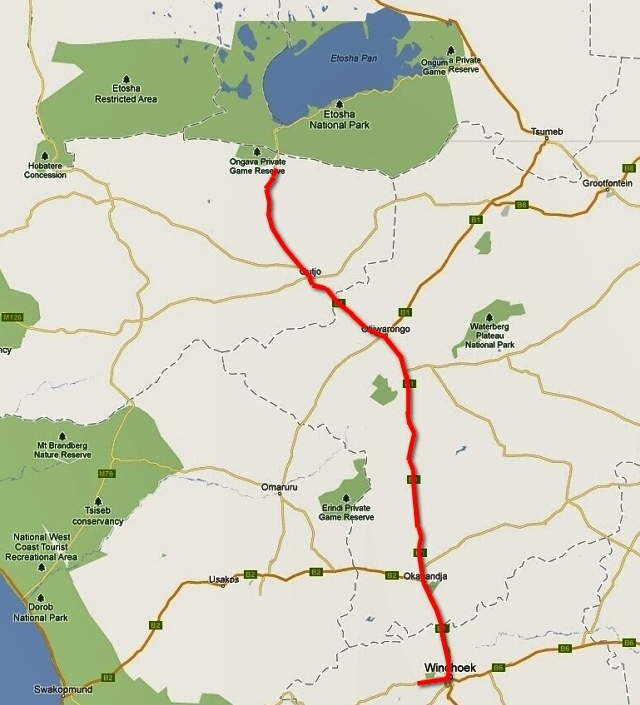| Cycling South Africa |  | |||||
 |
 |
 |
 |
 |
 |
 |
| Nothing compares to the simple pleasure of a bike ride. J.F.Kennedy | ||||||
| Three-month cycling trip, starting in late August 2012 in Windhoek, ending in Cape Town. Author's 9th expedition (New Zealand, Australia, USA, Canada, Alaska, Japan, Mexico, Bolivia, Chile, Argentina). |
|
To Etosha National Park
Error, Shameful Error
Everything played into my hands. It was a Saturday, with minimal traffic. It gave me time to gradually get acquainted with the behavior of the bike and to learn to handle the fully loaded bike. This task usually takes about two hours and then I have it under control and, on the contrary, later I am taken by surprise how the bike behaves without a load. This year, it was more difficult, because I had two new pannier racks, the weight was distributed a little differently and I was pondering all the time whether to move the bags, and in what direction. I cycled through the town without any problem, not paying much attention to navigation and especially absorbed in the behavior of the bike. I entered the road to Swakopmund. I knew that it went via Okahandja, no problem. Then I cycled through a “borough” of slum dwellings beside the road. I did not dare to take photos, as everyone was staring at me and I considered it unfair to them. Corrugated iron shacks, the size of half of a one-car garage, a piece of cloth instead of doors, no windows. Toilets always shared by several shacks, formed by a square meter bounded by branches with plastic bags hanging on them, so that not much could be seen. That was how the rich lived. Paupers had just a marked area, slightly disguised with a piece of plastic foil, no roof. So I contemplated what people in Europe were always complaining about while I diligently pedaled into the hills. I had already covered 25 km, the road began to narrow sharply and I began to suspect that all was not as it should be. I finally deigned to look at the map and it was immediately obvious that I was on the wrong road. With all the tuning into cycling, I had hit on another road, from which, however, there was no connection to the correct one. As can be seen, I was ready physically, but my mind was not fully tuned into the roaming yet.
I had to cycle back to Windhoek. I thought that, if I made it by 12 o’clock, I would still head for the original route. Otherwise, I would return to the hostel, tell them a lie about problems with the bike to avoid embarrassment, and sit quietly ashamed in a corner. The route from the hills was fast and at literally five minutes to 12, I turned on to the correct road. Road B1 posed as a highway for about 20 km with wide verges, so the cycling was smooth. Then it became a normal road without verges, I had to watch for trucks in the mirror, but otherwise it was fast because the road was still slightly downhill. I was on the alert, due to the habit of local drivers to overtake regardless of a bike coming from the opposite direction. A few times I was driven off the road.
No sights, boring scenery. Due to to the yellow, dry grass and rocky hills, I felt as if I was in Australia. This impression was disturbed by a pack of baboons frolicking in the Okapuka River bed when I crossed it. Before I could get out my camera, they had moved off into the trees. There were rest places under the trees beside the road. I stopped only if there was no one else there.
I arrived at Okahandja at 16:00. There was a campsite next to the road, where I was accommodated for 80 local Dollars (8 USD). A hot shower, drinking water, a kitchen with a stove and kettle, a grassy area for the tent, what more could one ask for?
At the entrance to the town, I was enticed by the advertisement for the local beer which is really good. I did not even wash, pitched the tent and ran to the store to make it before dark. But oops! Alcohol was not sold on Saturday afternoons! The local restrictions are moderate on weekdays (sales close at 18:00), but on Saturdays open hours are only from 9:00 to 13:00 and on Sundays and public holidays, you cannot buy a single drop. But I so craved a beer that I could not do without it. I cleverly went to the local Shebeen and bought beer there. This 'pub' varies considerably in appearance from those in our country. The barman – or rather, the salesman – because he sells only bottled beer, stands behind solid bars. You place an order, he tells you the price, a kid gets it ready, but the lady at the cash desk behind bars first takes your money and only then do you get the merchandise. It was difficult, but I enjoyed the beer even more. In the evening, one of the campers came to talk to me – a Namibian pastor from a town on the border with Botswana. He told me to not leave my bags on the bicycle overnight. There was a squatter camp (a slum of corrugated iron shacks) next to the camp and the smart guys would cut through the fence and steal from campers at night. They had stolen his picnic box with food and utensils which he had left in the front of his car.
Am I going to sleep "in the wilds"?
Animals respected me during the daytime. Warthogs (bristly pigs with extremely ugly snouts), Kudu and baboons quietly grazed next to the road without being disturbed by passing cars. But as soon as they heard the rustle of my tires, or perhaps sniffed the yet-not-so-intense smell of my clothes, they ran in panic from the road. I saw very many of them, but did not manage to take any photos. And so I cycled on, looking out for a place to sleep. I favored one tree, but when I approached it, an angry warthog rushed out from it. Well, I am not sure what he would have done at night, after finding his den occupied by a cyclist.
Increasing Appetite
The ride to Otjiwarongo went swimmingly. Almost a plain, windless, with only a tailwind for the final 10 km. The sky darkened heavily, twice it even rained a little, each time just a few embarrassed drops fell. In Otjiwarongo I found the camp almost in the town center. But it was a crappy, dusty campsite, with dirty, dusty tables and benches. Although the toilets were clean, there were no shower heads in the washroom. Nevertheless, hot water was available. Because I was in the camp alone, I also inspected the women’s washroom. Compared to the men’s, it was a difference of two classes. Clean, curtains, showers with benches. So I temporarily declared myself a lady and used that one. There are two supermarkets in the center. I went to SPAR and was again surprised by the high standard of the local stores. About ten ready-to-serve meals in the delicatessen section, with many side dishes and salads. I bought a cheap but delicious lunch – fried fish, baked potatoes and boiled vegetables. In addition, a cold Windhoek Lager. This is the beer I liked the best of all the good local beers. I took it to the camp and there I stuffed myself. However, I did not know that that beer would be the last one for the day. In the evening I bought a meal for the next day. I had skipped dinner due to my total satiation, but they would not sell me any beer. Although it was a Monday, it was a public holiday, so they exceptionally stopped selling at 14:00. I made some tea, pulled out the Kindle and read for a few hours until sleep took over at 8 p.m. Then I slept for eleven hours and at 7 a.m. crawled out of the tent as fresh as a daisy.
Outjo
I stayed in the large Etotongwe Lodge about 500 meters out of the town. The owner told me that it was safe there, but to be sure to lock the bike. "Because these blacks are simply desperate and steal and steal!" And he was quite angry with them and said how things would be better without them. The guidebook stated that there were the biggest racists in the local area, because tourism was concentrated here due to the nearby Etosha NP and that the Africans with their occasional excesses were ruining their business.
In the center, a young African man pleased me, asking where I was from. And he immediately blurted out that Petr Čech from Chelsea was his idol and that he too was a goal- keeper. It has happened to me already several times that people know the Czech Republic through football. One can see the result of our participation in the European Championships. Then, in the pub where I had lunch, I met four young Czechs who had been traveling in Namibia by car for three weeks. And I crowned my social contacts with a half-hour debate with a man who was building a house on the plot adjacent to the camp and who was watering the trees along the fence. He ran a drilling company, mainly searching for water and minerals. It is true that he too was cursing the blacks – they worked hard for him but had no respect and sometimes did crazy things. But he assured me in particular that the water was good everywhere there. You can always drink running water from the taps without any problem, he claimed. Only in some areas, the untreated water had too many nitrates, but that was a problem only for infants. The road to the Etosha National Park was boring, which I had become accustomed to. Plain, drab landscape, one merely had to pedal to get through the 90 km. One is not allowed to enter the National Park on a bicycle or a motorcycle. Animals are used to cars, but people could disturb them. Therefore, getting out of the cars or even leaning out of the windows is prohibited. Rangers rebuke people severely in this respect. Originally I thought that this was mainly to support the local guides of the Park tours. However, when I saw lionesses 10 meters from the road, I had to agree with them. They would probably play with me nicely if I passed by on my bike. I got accommodation 8 km from the Anderson Gate Park boundary. The Etosha Safari Camp was pleasant, camping on the grass cost 120 N$. Draft beer at the bar and a buffet dinner cost 185 N$. Moreover, there was a pleasant pool where beer was served. I was in Paradise.
My main concern was, of course, to see the National Park. The camp advertised a whole-day trip with a guide for 800 N$. I wanted to book for that, but at noon, when I arrived at the camp, there was no one else interested and a minimum of two paying passengers was required. They said that this should be clear by 18:00 and to enquire then. I did not stress too much about it, believing that it would all work out. But to make sure, I arranged with the Czech excursion of six people from Velké Popovice that I could, if necessary, join them. But it was a last resort. They were suffering from colds and I definitely did not want to catch one from them. And it eventually turned out well. Finally, there were four of us, an American on a motorbike and a French couple who wanted to visit the Park with a guide first of all and then to drive themselves in their car.
Etosha National Park
We left the camp at 6:30. I had been up an hour earlier. Fortunately, my GPS has such a loud alarm that it wakes even me. The advantage was that there were just a few of us. The couple sat in the front and the American and I each had our own seats. So we had a free vista to the left and the right of the vehicle. The guide was a professional, knowing where and at what time certain animals could be found, and we eventually saw four of the "Big Five". The fifth is the Buffalo which does not live in the Etosha National Park, it being too dry for it. In addition, our guide had a pretty rare insight, knowing what his passengers wanted. When a car overtook us, he stopped and waited until the dust had settled. Likewise, when a car passed us from the opposite direction. Thus he was saving both our eyes and also our photographic technique. Simply a pro.
We started with the lions. They were quite far away. The guide lent me a powerful pair of binoculars which I could keep until the evening. I saw the lions feasting, indulging in relatively large ribs. After a while, we encountered three cheetah. And then it was an endless carnival of animals. At times it resembled a well-directed theatrical performance – one herd would leave, and immediately another came to the waterhole. And then the memorable elephants, in herds of about 30, alternated at the waterhole.
Our last lunch was in the Halali Camp, where the waterhole is arranged so that people can walk there freely to observe the animals from the hillside. The backdrop for lunch was provided by many elephants. In the afternoon we went to “hunt” a rhino of which there are about 300 in the Etosha National Park, so quite a lot. Finally we managed to see a black rhino lying down at a distance of 300 meters. He then went for a walk and I saw him through the binoculars in his full splendor. This is the most dangerous predator in the Park, without any friends. When he comes to the waterhole, all the other animals flee. Only elephants confront him and fight with him, but the result is uncertain. Sometimes the elephants win, at other times, the rhino.
We ended up at dusk, having also seen some giraffe and lionesses near the road. It was a long but amazing day. The advantage was the guide being familiar with the habitats of the animals and his comments complementing the sights we saw. Super! And of course, a different camera with a large telephoto lens and tripod were necessary, but for me it would have meant extra kilos of weight. So please settle for my photos taken with a compact camera which only has a five-times zoom.
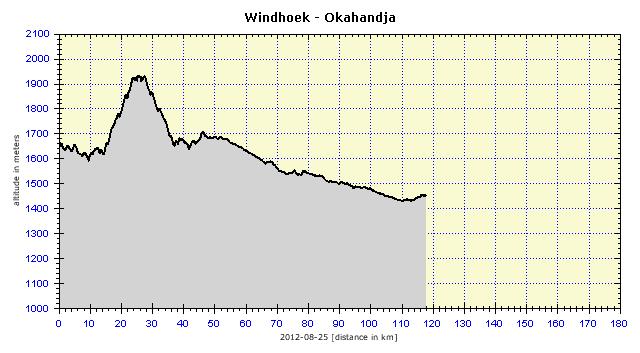 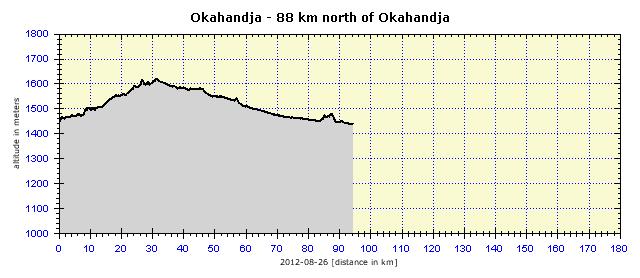 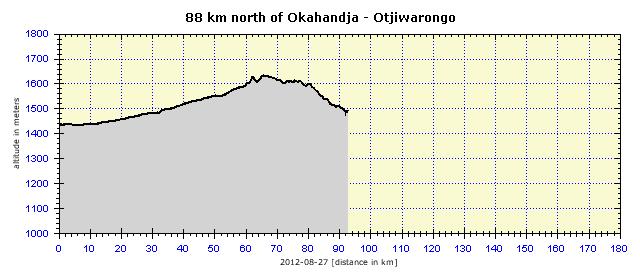 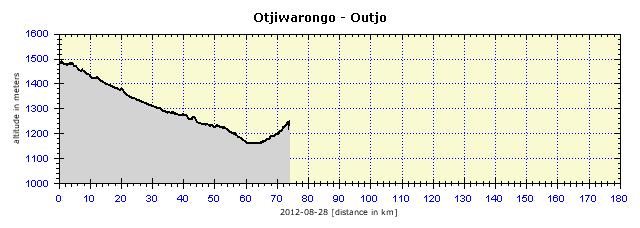  |
